
Battle of Leuctra

The Battle of Leuctra, July 6, 371 BC
The protagonists
Epaminondas (420 BC - 362 BC)
Born in Thebes around 420 BC, from a noble family but of middling affluence, Epaminondas had a meticulous education that could improve with daily attendance of the Pythagorean philosopher Lysis of Tarante, who, until his death, was a guest in his house.
He exercised in the gym, edited music and practised a strict accordance with loftiness morals and sense of humanity, rare in his day even in the most prominent men of Greece. Epaminondas was of aristocratic tendencies but had never taken part in the oligarchic Government and had kept away from political factions in his country. However it was a real Pelopidas's friend, a member of the Democratic Party, and because of this he had to leave Thebes for a period. In 379 a conspiracy led by Pelopidas claimed the oligarchs; so Epaminondas came up to the new Government with a host of young men that he grew to Republican virtues: that was the safest support for new freedom, leading to the benefit with all his sense of moderation and capable of uniting the forces against the outside enemies.

The crisis between Sparta and the new Theban regime, which had extended its supremacy to all Boeotia against Sparta in 371, exploded when Epaminondas, was elected beotarco (i.e. Supreme Commander of panboeotian Confederacy). During the Congress of peace met in Sparta to put an end to the conflict between Athenians, Spartans and their allies, Epaminondas refused to sign a peace treaty as delegate of the Thebans and the whole panboeotian Confederacy. Sparta did not intend to cede on this point because this would represent recognition of the Theban hegemony over that region. So was the war, which ended with the invasion of Boeotia and the battle of Leuctra (1 July 5, 371).
The Central Greece joined the Thebans and even in the Peloponnese spread the antispartan movement. Epaminondas invaded Laconia, giving liberty to the Messeni, which on the slopes of Mount Ithome founded the new capital Messene; but a pacifist party at home accused him of betrayal: he was acquitted but stripped of command. Later he returned with an army in the Peloponnese, in aid of the Arcadian League who founded Megalopolis; then (364) attempted to turn Thebes into a naval power by constructing 100 Triremes which flew some undertaking against the Athenian League; at the end of 362, for serious incidents followed in the Peloponnese, he start a new invasion, coming up in the heart of Sparta. Against the Spartans and Athenians allies he gave battle at Mantinea: with his usual method captured the victory but fell mortally wounded.
Brought out of the field of battle and learned that the Thebans had won, he let remove the tip of the shaft from which was wounded, and died peacefully, not without recommending to his fellow citizens to make peace, namely to abandon the policy pursued hitherto. With Epaminondas had been also wounded Iolaida and Defanto, his two best collaborators, so the great victory became infertile for Thebes. Epaminondas was therefore the greatest captain, a rare example of honesty and nobility of character, impressed strongly in the tradition. As a politician was not out-of-policy of his time and the patterns that had already lost the hegemony of Athens and Sparta: in fact, even the Theban hegemony, not supported by an ideal content, if able for a while to hold on and force momentarily the discords of the Greeks, could not be lasting.
Pelopidas (420 BC Thebes-Cynoscephalae 364 BC)
Theban general. In 382 he was banished from Thebes by the oligarchy supported by the Spartans and escape in Athens; in 379, back at home, along with the Spartan oligarchy overthrew Epaminonda and set up a democratic regime. Among the coordinators of the new army, he defeated the Spartans at Leuctra in 371, extending the Theban rule over Greece. During the Theban expedition in Thessaly, to lead mediation between Alexander of Pherae and the Thessalians, Pelopidas was taken prisoner (368), but was freed by Epaminondas in the following year.
Later, he was sent to Susa as Ambassador to the Persians; in 364 fell in the battle of Cynoscephalae, where he defeated Alexander of Pherae.
The Genesis
After the victory against the invading Persian army, Greece was not been able to find common language, culture, and incentives to build any kind of political unity. The disagreements have emerged during the strategic planning of the second Persian war. The differences in political and economic objectives that soon after led to the outbreak of a conflict, the Peloponnesian War, intended to last for nearly a century and ultimately leave Greece in a state of political and military absolute exhaustion. Military conflict between Sparta and Athens, based not only on different worldviews, especially on political and economic hegemony, was ended with the defeat of the Attica's city in 404, that was even forced to accept a humiliating surrender.
With the disappearance of the Athenian rivals from the political scene, it seemed that Greece had to undergo for a long period under Spartan hegemony. Sparta, that during the war had benefited from the Athenian policy of oppression and sometimes cancellation of traditional freedom of poleis, committed the same error that had, in the long run, lead Athens the defeat. In an attempt to give concreteness and effectiveness to their power over the Greeks, Lacedaemonians began to install puppet governments, often supported by the presence of Spartan garrisons in the major cities, with the aggravating circumstance that, contrary to what had done the Athenians, these Governments were expression of oligarchies over retrive, prompting even louder the popular discontent. Between highs and lows and with a series of political and strategic developments, the basic policy was, for better or worse, managed to remain for about 25 years.
It was in 381 BC that started the chain of events that will change forever the course of history in the Hellenic peninsula. The city of Thebes, which had been able to maintain a certain degree of autonomy, accused the Spartan Government of plotting against the liberty of Greece, with the Persian enemy. Actually this charge presupposed a good dose of hypocrisy, given that its friendship with the Persians and their economic support had enabled Sparta to reinforce his power over the other Greeks. As prepared to resist, Thebes was delivered by a conspiracy of oligarchic minority to a Spartan army, established a garrison on the Acropolis, enabled the oligarchs the establishment of a Government of terror and political and personal revenges. The majority of theban citizens bad stand this state of affairs and, after 10 years of the Government, rebelled, under Pelopidas and Epaminondas, hunting the oligarchic rulers and Spartan troops.
Sparta cannot allowed cracks to its power system and had to react immediately. So, between spring and summer of 371 a Spartan army under the command of King Cleombrotus invaded Boeotia and camp in the plain of Leuctra, near the walls of Thebes.
The "Invincible" Sparta
The battle of Leuctra, fought near Thebes, in Boeotia, in 371 BC, represents a major turning point in the history of the art of war in the Greek world. For at least four centuries the panorama of the art of war in Greece, evan in the numerous internal conflicts between the poleis that clash with the Persian invader, was dominated by the supremacy of the Spartan military system, never seriously endangered. Sparta wasn't always winning many battles out his Hoplites fought, however the strength of lacedaemon, the value of his Hoplites, recruited from among the citizens of law and the solidity of its institutions, less likely than in other cities, according to the political fortunes of the Peloponnesian cities, became a sort of reference point in the military thinking not only in the Greek world.
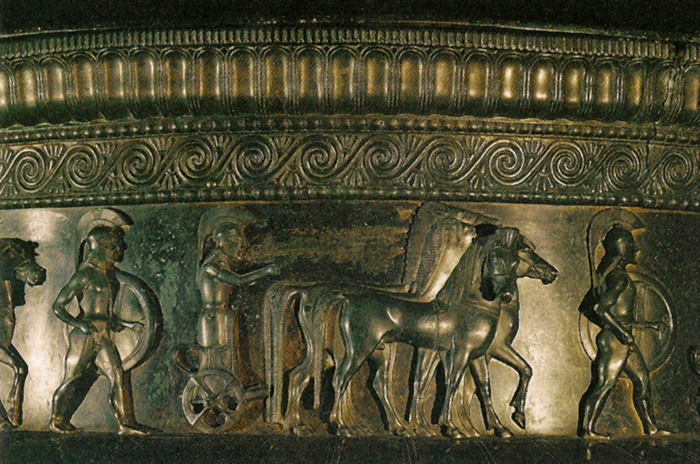
After victories in the messeniche wars, around the 8th and 7TH centuries BC, the Spartan power had spread throughout the Peloponnesus structured, according to the institutional system, traditionally traced back to the legendary Lawgiver Lycurgus, a strict military oligarchy, with a strict division into classes and a practically null social mobility.
The social organization of the Spartan State had allowed the rising of a citizen's class, omoioi, equal, able to devote himself solely to military training and the preparation of the war from an early age, giving the State a permanent war lacedaemon, highly and perfectly trained.
Towards other poleis, Sparta had then an army far more effective than all the public forces that the other cities were able to field. This system enabled Sparta to take, after the surrender of 404 BC, the Athenian hegemony over Greece, even if already contained the seeds of the crisis and its future decadence. Social organization, quality control of births, and the total lack of mobility within the Spartan society had long led to a weakening of the city and the State. Just when it seemed that Sparta had gained supremacy over other poleis the crisis emerged in all its drama.
In the plain of Leuctra the Thebans of Pelopidas and Epaminondas shows to all the ancient world this decadence, breaking the Spartan phalanx and the myth of his invincibility.
The Spartan army
The origins of Greek history is, as we have seen repeatedly, the notion that the true citizenship is composed only by those of its inhabitants who, as a result of historical and ethnic reasons, were part of the armed forces and then lent to the State, and his defense, their person, their means and their work.
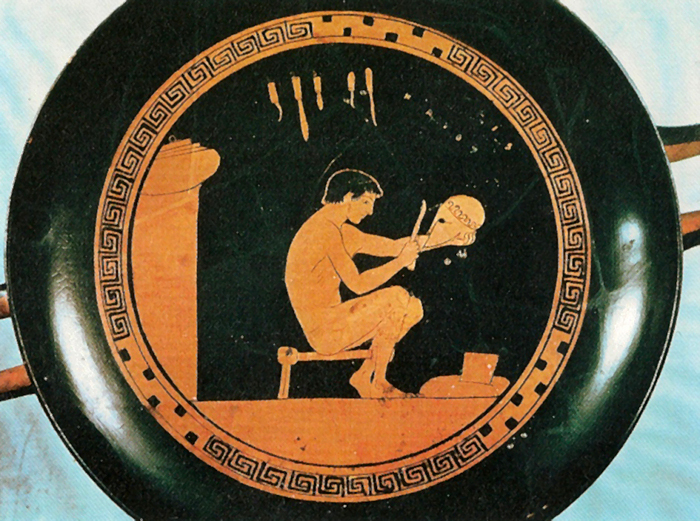
The Spartan army, in its origins, was composed of contingents from the three original tribes. All the Spartans included in tribe belonged to one of these three major units, had weapons and, in the event of mobilization, had to appear in their Department, while the Kings assumed the General command. In this primitive army, there were no other than the Spartans; anyway, it was only for them the role of direct combat, in frontline, which, in earlier forms of tactics, was a kind of hand-to-hand duel against enemies. So it's possible that the spartiate unit was composed all of promacoi, i.e. the category of chosen warrios for the first group. The pletys, i.e. auxiliary departments, services and supply units of the ancient Spartan army, could not exist, because it would be contradictory to the principle of equality between the homoioi (equal citizens, as we said before). In the Spartan army the pletys appeared only when Sparta regularly joined perieci(not pure spartans warriors) or when, exceptionally, merged toghether more Hoplites groups.
After the wars of Messenia there was a reorganization, attributed to the legendary Lawgiver Lycurgus. The large Spartan army units were called local, and were five, according to the new organisation of the State in five districts of lacedaemon. The military organisation of the Spartans wasn't only for active duty units, but concerned the efficiency and organization of the entire male population spartiate by 60 to 18 years.
So, in the spartan world, the Organization of sissitio, i.e. the grouping of smaller units: even if there were on leave they were obliged to take meals together, so that keep them in constant contact. One sissitio included 15 men and their official, then were 16 members canteens; with two sissitio spartans can formed a more tactically efficient department in the articulation of the main unit, i.e. the enamotia, that would then be formed by 32 men, including two officers; the command of the Department was given to the older of the two officiers. The Lenomotia replaced, in this new shape of the Spartan army, another Department of 30 people, that must have been, since ancient times, the basic tactical unit of the Spartan army. In sec. V, the Spartans began to form autonomous departments of perieci and enlist Helots(not the highest social class in Saprta) in the army, in a fixed proportion of seven Helots per Spartiate, entrusting to the Helots all services constituting the basis for the first line.
Before the Peloponnesian War, in the first half of the V century, other, new and profound reforms were introduced in the Spartan army. The perieci were widely recruited, and scattered in the various departments to avoid regional groupings that would have led to riots. In this century, it established the principle that each Spartiate was soldier of heavy infantry (Hoplite) or had to serve in the cavalry even if the Spartan cavalry was always very poor staff. During the Greek-Persian wars, it was still the recruitment based on 5000 Spartans Hoplites, 5000 perieci Hoplites and 35,000 "military servants" Helots: five local could have 9000 men each, naturally including the "services role".
The reorganization of the 4th century BC
In sec. IV, the Spartan army had a subsequent reorganization, which is known through the work of Xenophon on Government of the Spartans. Major units were created, called morai, one of cavalry and five of heavy infantry. The morai were divided each in four locai, eight enomotie and sixteen pentecostie. The major officiers consisted of a commander of mora, with the name of pale-marco, by four locagoi, eight penteconteri and sixteen enomotarchi. This whole reform corresponds to the need of articulate this more departments, because above the locos, whose staff will certainly be reduced by increasing the number, created a Department that replaced him, although, overall, the main unit will reduce from seven to six. It is also possible that the increased division of departments was due to the usual needs of the Spartan military administration to avoid regional concentrations, which, at the same time they had to resort to a growing perieci recruiting, had to simultaneously meet the demographic decline of the category of Spartans. For security reasons, the only way to reconcile these two requirements was to disperse perieci, and possibly the Helots, in smaller departments and more numerous because the Spartans could better supervise them. It is likely that, during the Peloponnesian War, that has introduced the principle that the Spartans, in any case, should be the responsible for the sized smaller departments.
The military obligations were, as mentioned at eighteen and not ended up that to sixty; though the younger classes and the elderly were kept as reserve for extreme cases, as happened for example in 418. In general, the two grades of younger and ten of the older, were exempted from active duty, then narrowed to men between twenty and fifty years. At the beginning of the V century, the perieci were still autonomous departments. The three hundred men of the Royal Guard were called hippeis; but they were "only" Cavalry soldiers. The cavalry was formed with other elements, but the Spartan war doctrine did not gave a great credit to cavalry units, excepting for cavalry reconnaissance, since it was based on the principle of heavy impact mass formed by the deployment of infantry equipped with heavy armour (Hoplites).
The Hoplite is the most typical and characteristic of the Greek soldier in general, and not just basic. There was a direct derivation of classical age Hoplite soldier from the Mycenaean period: a man armed with a large shield with the shape of an "8" made with ox skin, kept hanging around his neck, while the equipment was completed by a metal helmet. Mycenaean soldier also had a long sword, not very heavy and rather thin. In the following periods, still remained the concept of this type of rather heavy armament, without overload soldiers with a large shield, giving them an armor covering his chest, his belly, and horizontally wide apart. So that, the shield was reduced in size, and became a large round or elliptical plate, much smaller than the Minoan one, which could be supported just by the left arm. To complete this perfect war-engine, then, the spartan were armed with a long spear, a little higher than the person, and with a short two-edged sword. The spear was taken with his right arm, while the Sabre was hanging on the left. This type of registration was almost never changed during all the classical age.
The mercenaries
The institutions of many of the Greek cities for the city youth, included a regular military training period, called the efebia, which was done by and at the expense of the state-city. In Athens this service was imposed on young people aged 18 to 20 years. Due to the requirement of efebia, there weren't young Greeks without a minimum of military education. It is not hard to believe that, for the fact that pretty much lacked regular military uniform forms, there were elements of formal military training who remained in use up to our times. The Greeks also had fixed formulas similar to nowadays orders, as the equivalent of "right side" which flank for Greek troops as "turned toward the spear" or "left side", that meaned "turned towards the shield".
Trained in this way, the Greeks had a great, long military reputation, and, during the Peloponnesian War, the warring parties tried to increase their usual mercenaries hiring politics, to reinforce the hoplitic departments and to introduce the surprise of new combat methods. Cretan archers, Slingers of Rhodes, Thracian Peltast, as examples, were widely used. The end of the war and the reversal of the economic conditions in the fourth century, gave rise to a large availability of men ready to serve in mercenary troops, among the ranks of anyone able to pay. For their wars, the Phocians recruited 20,000 mercenaries soldiers, provided by the Treasury of Delphi; in the uprising that Cyrus tried against his brother Artaxerxes to deprive him of the throne, was hired a famous department of 10,000 men, the one who was protagonist of Anabasis commanded and narrated by Xenophon. Most of the 10,000 survivors of Cyrus were hired by the Spartans. Meanwhile, in Sicily, Carthage and Persia continued to be hired large departments of Greek mercenaries.
The pay for the mercenaries was not very high: Cyrus paid a darico per month, i.e. four oboli per day, which was exactly the same pay paid for the Athenians Hoplites during the Peloponnesian War; however, in mercenary troops, each combatant soldier had the right to have a sort of orderly, who raised his master from the effort to bring the shield and provisions (each soldier called to arms had to shows up at the department with the food for three days). In exceptional conditions, even during the Peloponnesian War, the military money was increased by one third, i.e. born to a drachma for the Hoplite and for his orderly. The mercenary's official had eight mites per day to local commanders and sixteen mites per day for general officers.
As we said, the development of the mercenaries hiring in the Greek world had a progress over the course of the 4th century. Alexander hired many mercenaries, but used only for garrison and other auxiliary tasks, since, for large military operations, he preferred the Macedonian army and public departments supplied by the Greek cities. Moreover in the persian army fought at least 30,000 Greek mercenaries, causing no small worries in Alexander the great, that tried any possible way to discourage them and urge them to pass into its ranks.
In the course of the 4th century was considerably developed the system of organization of mercenaries and their use in war. Until the Peloponnesian War, mercenaries were few and, outside of the gatehouses of the tyrants, the lever of the citizens was used predominantly throughout the Hellenic world, except that in Sicily. Moreover, many Greeks who were not satisfactory by their working conditions at home, before the conquests of Cyrus, were largely hired by Egyptians and Babylonians in Mesopotamia. The practice was not even down after Cyrus, because especially the satraps of Anatolian region used to hire Greek and many departments were available especially in Arcadia region.
The Phalanx
The term derives from the Greek falanx, meaning "roll". Is the order of battle of the classical Greek infantry. Used first as the only appropriate training to resist, for compactness, the messy Asian hordes and attack from the wagons, the Phalanx, particularly suitable to movement and to maneuver, led the Greek military art at a high level, allowing Epaminondas to implement his tactics, and Alexander at the realization of the strategic concepts among the most daring and brilliant in history.
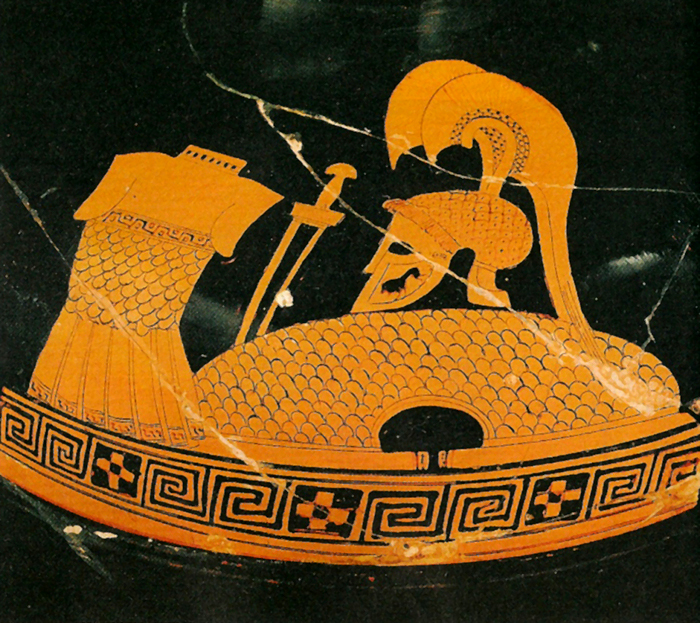
The Macedonian army of Hellenistic period, formed the phalanx of 16 Hoplites sintagma tightened next to each other: the sintagma was a 16 square file for 16 rows of men. The Hoplite was the armed with a "sarisa" (a spear over 4 meters long). In defensive combat the Hoplites of the first 6 rows downgraded their sarisa, pointing towards the enemy and he stops it on the ground with both hands, so as to break the wagons and attack any attempt at breaking into the compact formation; the other ten lines raised into the air the sarisa to cover the previous rows from arrows. In offensive combat the Phalanx advanced compact, with sarisas partly lowered and partly raised, as is said above, smashing the opponent with the power of impact.
The Phalanx, despite its compactness, had vulnerability points on the sides and on the back; consequently his troops into battle was normally guarded on each side by a cavalry corps composed of 8 squadrons, each with 8 riders in front and 8 deep; on the back, however, by a mercenary Peltast's rearguard, consisting of 16 light infantry unit each of 16 men in front to 8 deep, depending both on the reserve and rearguard. With Alexander, the phalanx was relieved in the number of the liness and rows of Hoplites, making it more suitable to the movement in varied terrain. The Phalanx was normally employed at the center of the deployment and, in part, resting on a wing, with a huge cavalry formation designed to maneuver on the side and rear of the enemy or ready to exploit the eventual success by pursuing.
This kind of heroic combat had much to do with the order of battle in which the Greeks fought the Persians in the early fifth century, when the Hoplite phalanx had become the normal type of military forces around the ancient world. The impact of phalanges was a contrast of masses, in which stress and weight were the decisive element of the battle. The phalanx had no chance to recompose if the enemy assault, with its weight, could destroy its front, and this order of battle did not need nothing other than to contrast a shock masse to one another, without any possibility of manoeuvre, other than preparation of an ambush that hit and surprises the enemy while he was in running order and not in order of battle.
Overall, the Phalanx did not have utility when it came to giving the assault on a fortified town, where even the women and children, from the top of the walls, could kill attacking soldiers just throwing stones at them. Similarly, at the battle of Plataea, the Persians had fortified their camp with a palisade, and the impact of the falange was used very little against this modest defense. The battle was decided under the palisade when, the Athenians who, fighting, can open a break in the palisade and enter the Persian camp and decided in their favor the fight. The battle of Plataea reveals, however, that the use of the infantry Hoplite phalanx was not intended in any case in a so strict manner: the Phalanx was not only used as mass unit, smashing shield against shield, for elementary forms of combat.
When the crops were ripe, it could happen that from a neighboring town was send a military unit to invade the territory, trying to take the harvest and even livestock. In a case like this, the whole defensive strategy consisted in deploying the Phalanx, in appropriate locations, possibly at the boundary line. The troops were deployed in depth by several armed men lines so that occurs with the invader, the shields of the two front rows come in physical contact with one another, each of the two front rows trying to push back the enemy, while all the rows behind, deployed in depth, help with the shields and with the arms to prevent the first row backdown. This singular fact could multiply itself in a combat with thousands of men becaming not too different from a 'tug of war' or from a scrum in the game of rugby. If any of the first row fighters was killed by the enemy, his place was taken automatically by another woarrior of the back row; and all the lines, until the last one, scaled in the same way. If, for some reason, this movement could not be done, began the clutter that could mean the defeat.
From this very simple and primitive form of combat, you could move on more complex actions, in which the importance of the individual element became more considerable, when the soldier was trained to move and fight even if it wasn't shoulder to shoulder and shield shield with its neighbors.
The battle
The Spartans and their allies were more numerous of the Theban army and, most of all, counted among their ranks at least 2,000 Hoplites with their reputation of invincibility. Epaminondas, who had taken control of Theban policy, however, managed to persuade their citizens about the importance to resist. The Theban army, 9,000 men, including 6,500 hoplites, moved as well to meet the 14,000 enemy warriors camped near the town.

The Spartan army was deployed for the combat in a sort of broad and flattened crescent moon formation, with the concavity pointing towards the enemy; on the right of the line, in the place traditionally considered more honourable, were the 2,000 Spartans Hoplites; among them there was the King Cleombrotus. But there were new tactics on the side of the Thebans. Epaminondas had deployed the army in a hitherto unknown formation in the battles of Hoplites: he turned down the right flank, with an oblique formation, had deployed on the left the elite division of the Theban phalanx led by Pelopidas, called the sacred battalion, in a very deep formation, composed of 50 ranks instead of the usual 12, and finally placing in front of this Hoplites unit his cavalry.
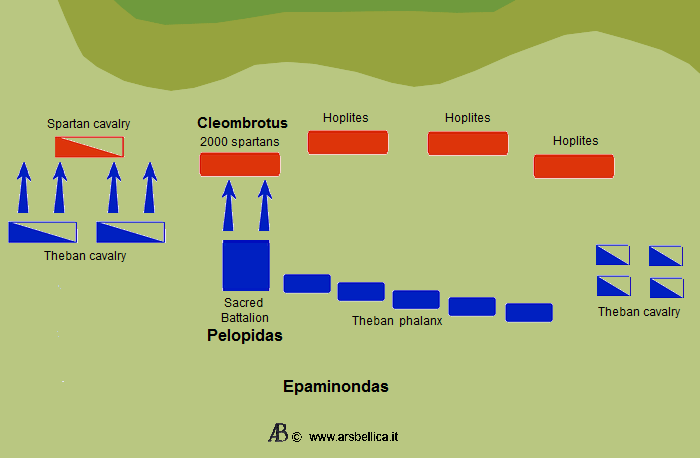
It was on the Theban left side that the battle was decided. The Theban cavalry, slightly larger in number than the enemy, routed the enemy and so was able to protect the Theban left flank while the phalanx of sacred battalion, with Pelopidas in frontline, crashed against the lacedaemonians. Immediately started a violent scrum but, slowly, the greater weight of the Theban formation began to prevail.

Epaminondas knows well the difficulties that had Spartan troops to maneuver on the battlefield: in fact, the Spartans attacked in that way, had as a single logical countermeasure to accomplish: an evolution to the formation on the right, to hit the side that the Thebans necessarily left uncovered.
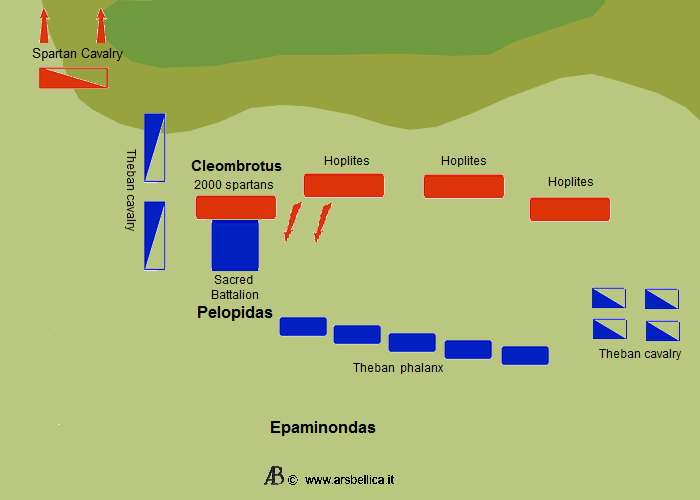
As Epaminondas had planned, the manoeuvre was too slow and against the Spartan phalanx, too much expanded, Epaminondas was able to send a division leaded by Pelopidas with 300 chosen men to attack the Spartans in the critical moment of their manouvre.
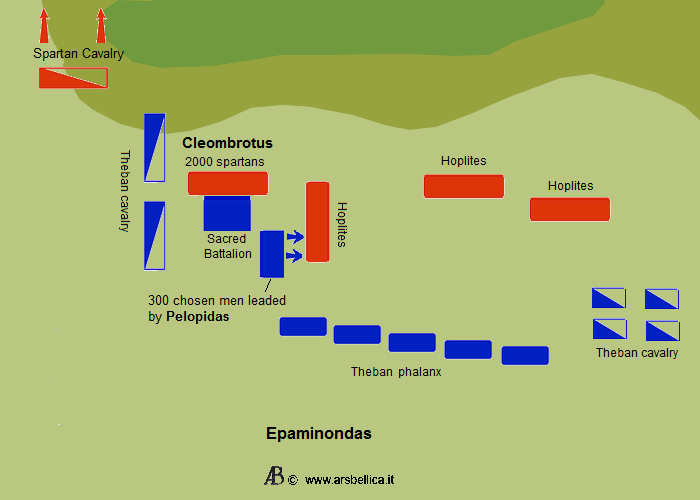
The Spartan phalanx was unable to remain compact and the battle was won. Epaminondas had applied to Leuctra a tactical expedient already known in Boeotia, consisting in to not get stuck in the middle, but to deploy one line, longer than usual, so as to keep some ranks as element of reserve.
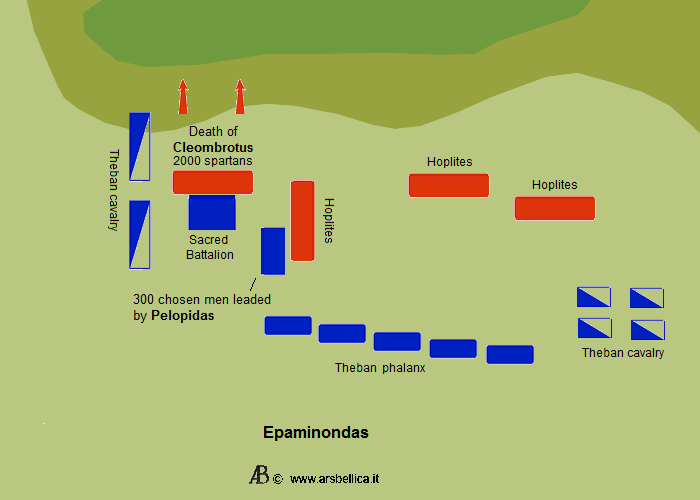
When among the spartans lines was knowned that along with many officials even King Cleombrotus was killed by the Spear of a Theban Hoplite, the Peloponnesian formation began to falter. It was what expected: Pelopidas pressed from boost the sacred battalion, so the Spartans suddenly starts to flee. The lacedaemon left wing had not yet entered in combat but, once watched the escape of the best troops on the field, they broke away from the formation and starts to route, chased by the Theban cavalry.
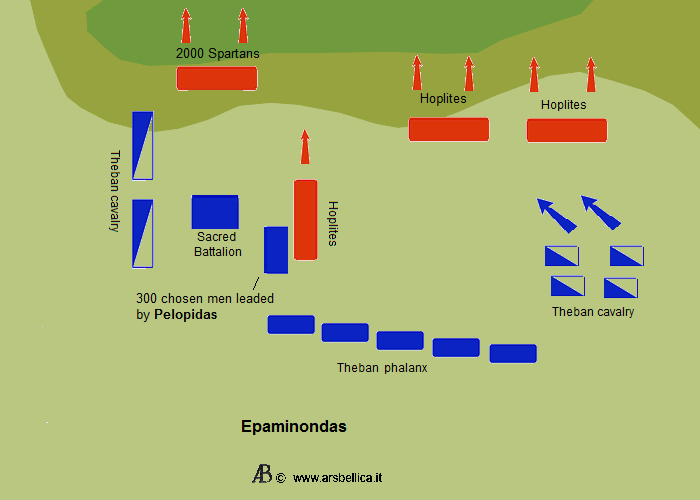
The battle had lasted only an hour and on the field remained more than 1,000 Spartans and only 300 Theban Hoplites.
With the ability to maneuver and the unscrupulousness of the Deployment, Epaminondas had obtained a decisive victory on what was considered the best army of the time.
The example of Epaminondas largely influenced the tactics of Alexander the great and caused some of its decisive battles, especially at Gaugamela (also known as battle of Arbela) against the Persian Darius (331 BC).
The consequences
The defeat suffered by the Spartans at Leuctra had disruptive consequences on political balances of all Greece. Unable to regain control of the city of Thebes the Lacedaemonians, who nine years later took a partial comeback in Mantinea, where Epaminondas died, were no longer able to maintain any form of hegemonic power, on the City-States of Greece. Left at the mercy of itself, the Hellenic policy returned to divisions and clashes that had characterized the period immediately preceding the end of the Peloponnesian War.
When it seemed that it could be established a clear Theban supremacy, loomed on the horizon another external enemy for the freedom of the poleis.
From the North, the Argead dynasty of Philip II, who in his youth had been a hostage in Thebes and were meet Epaminondas and Pelopidas, had strengthened the Macedonian state and, above all, had developed the strategic and tactical Thebans concepts in the reform of his own army.
This time the invader, the Macedonians, came from the North and, even if considered a barbaric element was, at least, of Greek language.
In 338 BC, at the battle of Chaeronea, the Macedonian army led by Philip defeated an Athenian and Theban army, ending, in fact, the freedom of Greece. Submitted politically, Greece did not see though disappear its culture; Philip's son, Alexander, who at Chaeronea commanded the Cavalry of his father, will be the man that bring Greek culture and weapons into Asia, preparing the field for the development that change the Greek civilization in what is known as Hellenism.
The Theban hegemony
The Theban victory at Leuctra and the death of Jason started the period of the Theban power. Meanwhile in southern Greece were serious civil unrest broke out. The rich still had the power, so the middle and lower class had arrived at a level of exasperation to be ready, as had already happened to Argos, to rebel.
In the Peloponnese snaked the discontent. In the eastern Arcadia was rebuilt Mantinea, and Tegea expelled 800 citizens who had secured their loyalty to Sparta. The appeal that the Arcadians had done to Athens was vain, luckier was that aimed at Thebes. Epaminondas decided to invade the South. Sparta was not in good condition, the spartans were decrease in number, and for the first time in the history of the city, an enemy army was raiding in its territory, encountering only a few resistance. Sparta was saved in extremis by the few allies who remained. Epaminondas rebuilt Messene with impressive fortifications to serve as a bulwark against Sparta (the splendid ruins of fortifications are still visible). Athens, however, hating Thebes even more than Sparta, in 369 allied with his eternal rival.
Epaminondas invaded Sparta several times, and the story of the years immediately following was characterized by the constant build up and dispose of alliances. In 365 Elis went to war with the Arcadia, and 364 new belligerents faced each other in a great battle at Olympia, in occasion of the traditional celebrations. Epaminondas was mortally wounded at Mantinea while pursuing victorious cavalry of the Athenians, Spartans and Arcadians. During his glorious career he not only gave a tactical lesson at the spartans, but had also founded or refounded two energetic city intended to keep Sparta under attack: Megalopolis, built in 370 BC by mountain peoples of Arcadia, and Messene, new capital of a Messenia no longer in thrall to Sparta.
However the Theban military power did not last long after the disappearance of its creator, Epaminondas, just like Jason's Empire did not survive to his Lord, or as was for the ephemeral power of Syracuse in Sicily.
Sources
Our Mobile Application
Check out Our Mobile Application "Ancient Greece Reloaded"


